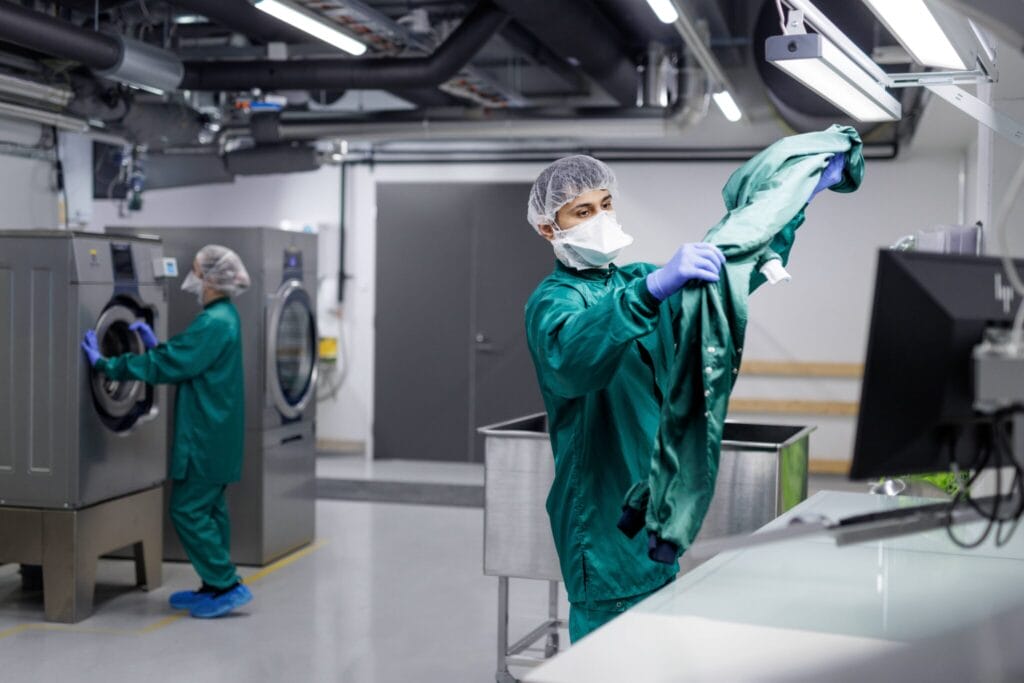
Mastering ISO cleanroom standards for compliance
In industries where contamination risks are high, the ability to maintain a consistently clean environment is a compliance requirement. Whether you’re manufacturing sterile pharmaceuticals, assembling semiconductors, or handling sensitive biological materials, following ISO cleanroom standards for compliance is required to continue successful business operations.
But what exactly do these standards involve, and how can you ensure your operations align with them? Let’s take a closer look at the core principles and practical steps you can take to stay compliant while also exploring how outsourcing certain tasks to partners like Lindström helps simplify the process.
What are ISO cleanroom standards?
ISO cleanroom standards, specifically ISO 14644-1, are internationally recognised guidelines that define the level of cleanliness required in controlled environments. These standards specify limits for airborne particulate concentration and classify cleanrooms from ISO Class 1 (the cleanest) to ISO Class 9 (less stringent).
The key idea is that the fewer particles in the air, the higher the cleanroom classification. Maintaining the correct classification is critical for protecting products, processes, and, ultimately, end-user safety.
In sectors like pharmaceuticals, where both particle and microbial contamination pose a risk, these standards are a foundational element of any contamination control strategy.
Cleanroom classifications and their purpose
Each ISO class is defined by the maximum allowable concentration of particles per cubic metre of air, with stricter classes requiring more rigorous air handling, filtration, and garment control.
For example:
- ISO Class 8 is common for general cleanroom gowning areas or background zones in pharmaceutical settings. It typically requires 20 air changes per hour and proper gowning discipline.
- ISO Class 7 environments are more tightly controlled, often requiring 60 air changes per hour, HEPA filtration, and more restrictive personnel behaviour and attire.
Understanding your required cleanroom class—and maintaining it—is fundamental to ISO cleanroom standards for compliance. And this goes beyond just HVAC systems or particle counters. Every element, from surface cleaning protocols to garment hygiene, contributes to the overall control of the cleanroom environment.
Implementing ISO cleanroom standards for compliance
Achieving and maintaining compliance is not a one-time effort. It’s an ongoing process that requires structure, training, and reliable systems.
Here’s how to approach it:
- Monitor air quality continuously using particle counters, microbial air samplers, and surface contact plates.
- Conduct a baseline assessment of your cleanroom facility and processes.
- Install or upgrade filtration systems based on your target ISO class.
- Implement validated cleaning and gowning protocols—this includes everything from zoning layouts to hand hygiene and dressing procedures.
- Train your staff regularly. People are the biggest source of contamination in cleanrooms, so habits matter.
Common challenges in achieving ISO cleanroom compliance
Even the best-planned cleanroom systems can face compliance risks. Here are a few common challenges, and how to address them:
| Challenge | How to Address It |
|---|---|
| Inconsistent gowning protocols | Standardise procedures and reinforce training |
| Garment contamination during laundry | Use a certified laundry provider with ISO-classified environments |
| Poor traceability of garment use | Implement RFID-based tracking systems |
| Lack of documentation for audits | Partner with providers offering full compliance records and service data |
Lindström helps mitigate all of the above with an end-to-end service that’s already aligned with regulatory expectations.
The role of Lindström in supporting cleanroom compliance
This is where Lindström comes in—not just as a supplier, but as a service partner.
We offer a full cleanroom garment service designed around the requirements of ISO standards, GMP, and the revised EU Annex 1. Our solutions are tailored for pharma and biotech environments where particle and microbial control are both critical.
Here’s what sets us apart:
- Garments validated for ISO Class 5–8 environments
- EN 14065-certified laundering processes, with unidirectional flow in ISO-classified laundries
- Performance-tested garments for filtration, breathability, and electrostatic behaviour
- RFID-tracked lifecycle monitoring through eLindström, so you never exceed validated wash or sterilisation cycles
- Regular audits and transparent documentation to support your own inspections
With Lindström, you gain control over one of the most important variables in cleanroom hygiene: your people and what they wear.
Comparing ISO cleanroom standards with other cleanliness standards
How do ISO cleanroom standards compare to frameworks like GMP?
- GMP (Good Manufacturing Practice) focuses broadly on the safety and quality of pharmaceutical production processes, including hygiene, documentation, and validation.
- ISO 14644-1, by contrast, is highly specific about airborne particulate control—measuring, managing, and maintaining air cleanliness through quantifiable criteria.
In reality, most pharmaceutical manufacturers must comply with both: making it vital to adopt a holistic contamination control strategy. This includes facility design, gowning practices, personnel movement, and laundry hygiene.
Keep your cleanroom compliant with less effort
Technology is reshaping how companies approach ISO cleanroom standards for compliance. Real-time monitoring, digital garment tracking, and data-driven insights are helping manufacturers move from reactive to proactive hygiene management.
Lindström is already enabling this shift through:
- Smart inventory tools via eLindström
- Lifecycle data that supports compliance documentation
- Modular cleanroom laundries located closer to customer facilities, reducing delivery time and emissions
By combining sustainability with precision, we’re helping pharma companies meet their ISO obligations without adding complexity to their daily operations.
Mastering ISO cleanroom standards for compliance doesn’t have to be overwhelming. With the right systems, partners, and mindset, you can build a cleanroom operation that is not only compliant but also efficient, resilient, and future-proof.
At Lindström, we take the hassle out of cleanroom garment management so you can focus on what you do best: delivering safe, high-quality products to the people who depend on them.




